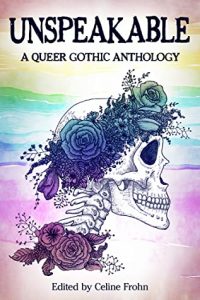This book had me in two words: queer. Gothic. I have long-held passions in both areas. The gothic is the realm of the outsider, the rejected, the monstrous. It lends itself to queer interpretation–and that is mostly what queer gothic is. Just interpretation. The height of gothic literature was, of course, the 18th and 19th Centuries, beginning with The Castle of Otranto and spidering out into different sub-genres and interpretations right up to the present day. There are queer interpretations of gothic literature, definitely: my favourites include Susan Stryker’s “My Words to Victor Frankenstein above the Village of Chamounix: Performing Transgender Rage,” and Skin Shows by Jack Halberstam. There is obviously The Picture of Dorian Gray, but also the interpretation of The Strange Case of Dr Jekyll and Mr Hyde as being an allegory for the closet, and the ambiguous sexuality of Dracula. The gothic is queer, inescapably. So when I saw Unspeakable: A Queer Gothic Anthology, my true reaction was to say, “oh. Finally.”
The anthology spans identities, each story offering up new characters with new queerness. A large proportion of the stories are about WLW–women who are seduced by vampires, who dance with the ghosts of their murdered wives, who kill their lovers, and fall for monsters from the deep. Sometimes these women are the ones who are monstrous, which is of course, the potential of the gothic. This is the most exciting thing for me, a feeling which is only compounded by the fact that their queerness is not what makes them monstrous. They are given power in their monstrosity.
The contributors to this anthology understand the genre to its core. There was not one story that felt amiss, each with the kind of rich and immersive prose which typifies gothic writing. I was pulled into each chilling tale easily and readily, the language acting as a kind of through-line for this diverse collection of stories. Even though each is by a different author, with a different approach to the genre, they read as part of a whole. The anthology is cohesive and interconnected, with some stories sharing similar themes and imagery in a pleasing way–the same hallmarks of the genre, used to different effect.
There are all kinds of queer women in these pages. Some of my favourites were the stories that explored the idea of a woman out of time–a woman with an identity which we might now refer to as butch, but constrained by Victorian sensibilities. There is something eminently enjoyable about a rakish and debonair Byronic hero in cravat and breeches, but oh wait! She’s a woman, and she’s here to seduce your wives. I enjoyed the troubled Kat in “Hearteater” by Eliza Temple, who has exactly the right amount of tortured soul.
And on that point–seduction. I haven’t yet mentioned one of the drawcards of the gothic, that being the simmering eroticism of all things dark and disturbed. There’s a reason why we find vampires so sexy. The authors of Unspeakable haven’t forgotten this, either. A number of the stories are filled with just the right amount of sexual tension and saucy contact. It is sometimes devilish, and always welcome. “Laguna and the Engkanto” by Katalina Watt stands out: a story with a folk tale feel which absolutely sizzles.
The stories that don’t have that note of the erotic are filled with another gothic (and queer) emotion: yearning. The sense of something lost, of a need to pierce the veil, to find some fulfilment and compromise your own goodness to do so… these are all gothic elements that are woven through the stories of Unspeakable. Remember that while the gothic is horror, it is also romance: it is heightened emotions, a deep plunge into the psyche and the human condition. “Moonlight” by Ally Kölzow is one such narrative, which left me with such a deep sadness that I am still thinking about it, days later.
It bears mentioning that a lot of these stories rely on tropes. These are, of course, conventions of the genre, and some might call them clichés. I think it is important to be reminded, however, that applying these “clichés” to queer narratives is something completely new. It is a reinvention, and it is inspired. Even though some of the stories are familiar and predictable, the expected outcome is the desired outcome: we deserve our turn with these stories, and they are all the more enjoyable for it.
This anthology is a powerhouse of an introduction to the work of some very exciting writers. Their dexterity within the genre is admirable, and made this collection an utter pleasure to read. For lovers of the gothic, it is an absolute delight. If you are unfamiliar with the genre, it is a perfect introduction (although be prepared for any further forays to be a lot more subtextual on the queer front). It was so soothing for me to be able to read within a genre so dear to my heart, and to see it full of queerness. At the risk of sounding over-the-top and extremely sappy, my devoted thanks go out to Celine Frohn and the contributing authors. They have created something truly special, which feeds the monster in us all


